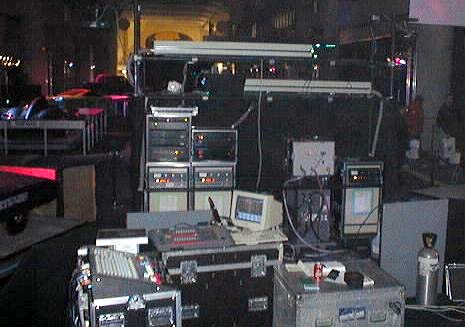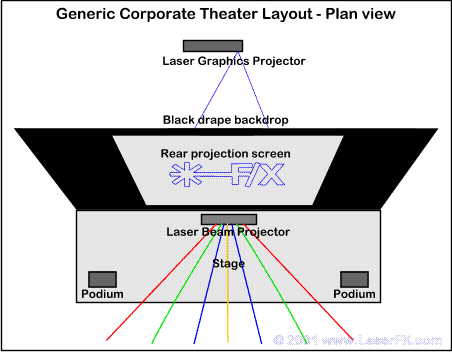|
Hiring
a Laser Show - Staging and Production
Laser shows can be used for many different
types of events where impact and unusual visual effects are desired.
There are certain staging and production issues that must be kept in mind
when planning for a laser show.
|

|
|
A backstage look at complex, full colour, high power
beam and graphics system used at an automotive show
- Photo by L. Michael Roberts |
Staging
In order to utilize a laser show at
your event, certain staging considerations have to be taken into
account. Firstly, the location has to have sufficient height so that
any static beam effects used can be separated from the audience by 3
meters [10 ft approx.] vertically and 2 meters [6.5 ft approx] laterally for
safety.
The second most important consideration is the
provisioning of utilities for the laser systems. Your venue has to
have sufficient power and water to operate the lasers - the water is
required for cooling the laser system(s). These utility needs will vary
depending on the laser system(s) to be used in the show - the laser
production company will supply you with the details. More modern Solid
State (DPSS) lasers may not require any cooling water
connection as they are generally air-cooled or may have a closed-loop
cooling systems with a hear exchanger.
Generally
speaking, the higher the power of the laser(s) to be used, the greater the
power and water requirements. For example, some models of 20 watt
argon laser require 480 VAC, three phase power at 35 to 45 amps a leg, as
well as cold flowing water at rate of 3 GPM with a pressure of 35+ PSI (in
the photo above, 3 high power lasers were used for the show requiring over
100 amps of three phase 480 volt power as well as 10 GPM of water).
The power and water connections should be conveniently located in relationship
to the laser position to keep cable and hose run lengths reasonable.
The third important consideration is that there is sufficient
space available to mount the laser system(s) and support equipment. If
your venue has limited space, it may be difficult to place the laser system
on it's scaffolding in the optimal position to get the most spectacular
effects. Laser beam shows look best when projected on the central,
longest axis of the venue - graphics shows need to be projected onto a
suitable screen or surface that is visible to everyone in the audience.
The last important consideration is that there is sufficient
time to do the laser system installation and testing. This is
particularly important in a large scale outdoor show where the installation
may have to be done the day (or two days) before the show so that the
system(s) can be adjusted
and tested during darkness the night(s) before the show. Even in the case
of an indoor show, "dark time" will be required to test and align
the laser system(s). "Dark time" should be scheduled in such
a way that the laser company is in control not only of the lighting in the
venue, but also the sound as it is difficult to communicate with staff
aligning mirrors when a sound system is in use, and the laser company may
need the use of the sound system to test audio playback and show
synchronization.
Production
As the show producer, you need to decide
how the laser will be incorporated into your overall show plans.
Lasers can be used in a number of way to add to your event:
Stand alone: The laser show is the main focus
of the event with an elaborately choreographed production consisting of
beams and graphics set to music to entertain the audience. This type
of show may be appropriate at a civic event or national holiday show where
the day being celebrated can be illustrated by the laser.
Laser and fireworks spectacular: The laser show
is used to enhance the excitement of the fireworks show. Laser shows
are often used in this format since they can add significantly to the
running time of a fireworks presentation at a much lower cost than adding
additional fireworks.
Special effect: The laser is used in a few
places in the production to add "punch" or "drama" to a
scene or to create an illusion. For example, a rippling sheet of laser
over the audience may be used to create the illusion they are underwater, or
a cone of laser may be projected over a new product when it is revealed to
heighten the drama.
Kick off: At a corporate or marketing event, a
laser show may be run off the top of the event to get the audience's
attention and insure they are receptive to the presentation that follows.
Spectacular finale: The laser show occurs as
the last part of the show to "wrap up" what has gone before and
insure the audience remembers the presentation. It is quite common to
combine the kick off show with a grand finale laser show to give added
impact to the event and utilize the laser to it's fullest.
Signage: The laser show might be used as
signage in a number of applications. At an awards ceremony, the laser
may be used to write the names of winners in large moving letters. In
a trade show booth or exhibition application, the laser may be used to
project company logos or product outlines above the booth to attract the
attention of exhibition goers. In a laser billboard application,
the laser can be used to convey a short repeating message with product or
corporate logos.
Dances and parties: In this type of application,
laser beam effects are generally used to emphasis or illustrate parts of the
music and to add excitement to the event.
Layout
In order to get the maximum impact from the
laser show, the layout of the venue and the positioning of the production
elements must be taken into consideration.
|

A simplified overhead view of a
generic laser layout for a corporate theater show utilizing separate
beam and graphics laser systems.
|
If you are planning an all-graphics
laser show, the screen (or other projection surface) must be the correct
size and placed where it is visible to all of the audience. An all-graphics
show requires much less laser power than a beam show or mixed beam/graphics
show. There are no hard and fast rules on laser projection screen
sizes. Since laser graphics do not lose resolution at large sizes, the best
strategy is to use the largest screen the throw distance, venue, (and
budget) can accommodate.
If you are planning to have
both laser beams and graphics, ideally you should have separate laser
systems for the two types of effects. Laser beam effects require more laser
power than graphics effects. Laser beam
effects always appear much brighter and more spectacular when projected
towards the audience (when the audience is facing the laser beam
projector). Placing the beam projector in the audience's field of
vision, e.g., below the graphics screen, gives the most effective beam
effects. With two laser systems, it is simple to place the beam effect
system below or above the screen while the graphics and animations can then
be front or rear projected as appropriate (see diagram above).
Laser beam shows look best when they can fill a
large area. In the case of a single laser beam projection system, the
best results are obtained when the system is positioned on the centerline of
the long axis of the venue with the audience facing the laser
projector. If it is impossible to position the laser in this manner, consideration
should be given to having two laser systems, one positioned on either side
of the area the audience will focus on. Note that for beam effects,
smoke machines must be used to create a haze in the air. If the laser
show is part of a larger show, sufficient time must be allowed for the smoke
to circulate through he venue to build up the haze before the laser show
starts.
More articles about laser show production can
be found in the Backstage area here.
[
Introduction
| Staging
and Production | Costs | Where
to Hire a Laser Show
]
|